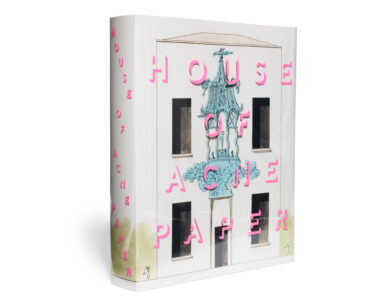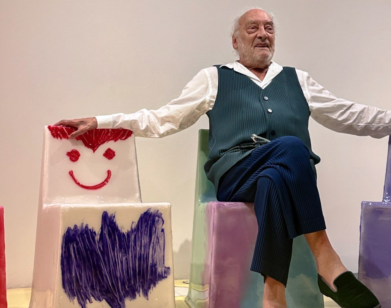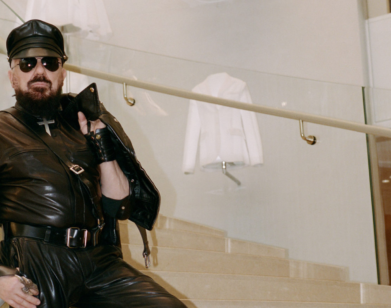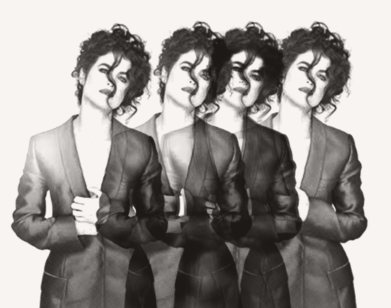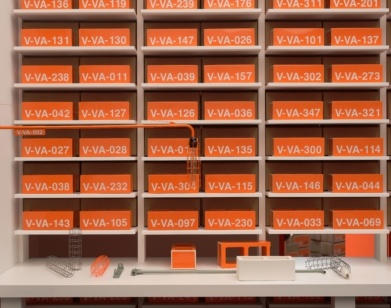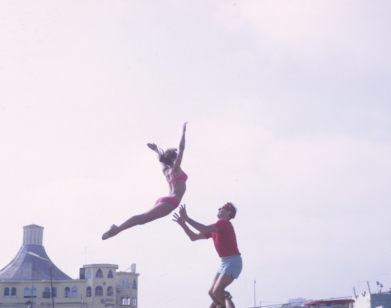Rem Koolhaas, the star architect behind Prada’s sets, opens up to his son Tomas
Earlier this month, a documentary about Dutch architect Rem Koolhaas, directed by his son, Tomas, was finally released after two years spent touring film festivals. Titled REM, it provides a closer look at the world-renowned architect, one that’s both introspective and retrospective. Rem discusses his relationship to celebrity, the metropolis, and provocation, while acknowledging the ways he’s challenged the field of architecture and challenged himself to create with distinction.
Rem Koolhaas grew up in Rotterdam, Amsterdam, and Jakarta before going to university in London during the Swinging Sixties and in New York during the early ‘70s. After co-founding his firm, OMA (The Office for Metropolitan Architecture), in 1975, he quickly earned a reputation for disruptive work that was deliberately in contrast to the postmodern movement. OMA buildings include Seattle Central Library, the CCTV headquarters (Beijing), De Rotterdam, and the Garage Museum of Contemporary Art (Moscow), and Fondazione Prada (Milan). In fact, OMA has a longstanding partnership with Ms. Prada, creating elaborate sets for the brand’s seasonal fashion shows in its windowless concrete HQ, and building a slew of their stores in L.A. and N.Y., along with their new foundation complex in Milan.
But back to REM. For three years, Tomas followed his father everywhere from New York to Beijing to Qatar, capturing Rem researching and working, as well as some of his best-known buildings and residences. He also showed his father swimming a lot—a metaphor for Rem’s constant sociological inquiry. “Nothing is more revealing than seeing how other people move in or near the water,” Rem says in the film.
Below, Tomas Koolhaas interviews his father about the film and the impact of looking back.
TOMAS KOOLHAAS: People are always asking me how it was different making a film about my father. Since this is the first documentary I’ve ever directed, but you’ve had numerous films made about you, it makes more sense for me to ask you. How did it feel different having your son make a film about you?
REM KOOLHAAS: Well, of course your relationship with your children has a totally different level of intimacy. You remember my initial hesitation to even do the film.
I never really thought it would be smart to reveal too much of my identity. Therefore, once I decided to do it, what I feared became reality. It was a much more probing, revealing, open, naked kind of situation. But once I surrendered to it, it was also a wonderful experience, simply because it helped me enter a different phase. The whole idea of privacy or working on keeping things to myself turned out to be less urgent.
TOMAS KOOLHAAS: In the film, you talked about having sudden realizations or breakthroughs that have had a ripple effect through your research and then ultimately, the built work. I felt that this was one of the most interesting themes of the film. I was wondering if any of the conversations we had during the film sparked epiphanies that eventually affected the research or the built work.
REM KOOLHAAS: It was not that there was one single epiphany, but I became aware that it was actually interesting to look back, which I’ve never done very consciously. I was always more driven, more motivated, and in a way, ideologically committed to looking forward. Doing the film helped me overcome that. For the same reason, through looking at elements of my biography, I felt that it made sense to consider their effect on my current situation. That was the revelation.
TOMAS KOOLHAAS: That’s interesting. Something just struck me when you were saying that. Do you think there’s a tendency to always look forward, not back, because you grew up during a horrific period—during a World War?
REM KOOLHAAS: It’s exactly that, but I also feel that I was very lucky to be born then. It was not as horrific then, because the war was over. It was more, let’s say, an optimistic ruin. I’m very lucky to have experienced both the ruin and the optimism. It’s not that it was so horrible that I didn’t want to look back, but looking back is very complex. I never really wanted to deal with that kind of complexity when I was making arguments, or building arguments, or building cases, or building narratives that are basically to do with the present.
TOMAS KOOLHAAS: That’s interesting. I feel like I also have a tendency to look forward, not backwards. Perhaps there’s a genetic component to it, too…
In an early section of the film, you talk about having been, and still being, a journalist. In another section, you say that you “ask the right questions.” Do you innately possess these skills, which happen to be beneficial for both journalism and architecture? Or did you consciously use the tools you learned as a journalist and apply them to architecture?
REM KOOLHAAS: It’s extremely hard to separate. Basically, the one driving force behind all of this is curiosity. Asking questions is simply the main model of my interaction with the world. At some point, that impulse became more professional, also as a journalist, but I think the energy is derived from the innate curiosity and not necessarily from the profession of journalism.
TOMAS KOOLHAAS: That makes sense. How did it feel watching the film and seeing people, such as the two homeless men, Chris and Phil in Seattle, and clients like Louise Lemoine and Laure Boudet, talking in such a deep and personal way about how your work has had a powerful effect on their lives?
REM KOOLHAAS: I’ve never openly thought about it in that way. Of course, I was aware, in general, of these kinds of experiences. I’m also very happy when I have a sense that on the whole the effect [of the work] is not bad, and there are moments of euphoria on the part of the clients. We may also have been very spoiled with those kinds of testimonies, but seeing them so earnestly displayed, and so openly articulated, was really gripping and moving. It really made me think a lot.
TOMAS KOOLHAAS: In terms of format, how does it feel to physically see the faces and hear those kinds of emotions, rather than, let’s say, read them in a book? I can imagine that would be a big difference. Do you think these thoughts will affect things, going forward?
REM KOOLHAAS: It’s really strange. Basically, if you do architecture, at first you do the planning, building, et cetera, and you don’t ever see someone who is going to use it. Then, something opens, and suddenly you see too many people to individually consider, and then you disappear from the scene. The confrontation and the tangible evidence of these people on film was incredibly strong. Of course, it also corresponds to a secret desire—to actually hear what people really think and to witness what they really feel. There is almost a voyeuristic satisfaction in seeing how strong the effect actually was.
It’s not so much that it’s the first time I thought about these things, but the film makes it inevitable to articulate the thinking more explicitly. It’s really the difference between implicit and explicit preoccupation. So yes, I think from now on, it will be different.
TOMAS KOOLHAAS: That’s an interesting point. It made me think about another question that you maybe don’t have the answer to, but I wonder what your theory is. Why do you think, given the strength of those kinds of stories, that no one had incorporated them into a film about your work before?
REM KOOLHAAS: I think that it’s simply because of the intimacy I felt throughout the film and the invitation to reconsider many things—to look back. The same model and relationship applies to Louise [Lemoine] and Laure [Boudet]. They know you, so I think it worked exactly the same for them. The homeless man [at Seattle Central Library] is a different case, but perhaps he also felt some intimacy, simply because he was being asked what he thought. That probably doesn’t happen very often to him.
TOMAS KOOLHAAS: That’s exactly what he said. He said, “Thank you for making me not invisible, for once.”
REM KOOLHAAS: Exactly.
TOMAS KOOLHAAS: So, another important part of the film is about New York. Seeing you walk through the streets, and hearing you talk about it, I could feel the genuine affection you have for the city. That was touching to me. New York is almost unrecognizable now compared to when you were there in the ‘70s. When you go there now, how does that change strike you?
REM KOOLHAAS: I realize the change more and more. In the ‘70s, I was totally enthusiastic about New York but also about the model of New York. I really thought it represented something that could be copied, or something that had a secret code, in which almost everything could be organized. As you know, I wrote a lot of lyrical but also intellectual passages about the beauty of the grid [in Delirious New York]. In the experiences I’ve had there since, I’ve noted that there are so many new phenomenons—so much traffic, such a different sense of order, such a different culture of coherence, such a reduction of consensus, such individualization, and such a mixture of cultures, which makes it impossible to simply adopt a single, one-model-fits-all situation. It’s impossible to think of New York in the same way—as something that has potential for the future.
TOMAS KOOLHAAS: Well, that takes us perfectly to my next question, which is about the countryside section in the film. It opens with your quote, “The city is no longer, we can all leave the theatre now.” That section is about the countryside, but not just one countryside—the various conditions of countryside that exist around the globe. As we just talked about, you spent most of your career studying and building cities. Why shift away from it now?
REM KOOLHAAS: This was a very strange and almost unconscious phenomenon, where I really began to realize that, despite all of my explorations, investment, and interest in contemporary cities, including cities in Africa and China, I was overlooking something basic—the total and radical effect of globalization. Not necessarily on urban culture, because globalization and urban culture are very compatible, but how globalization was actually changing the countryside much more radically.
Of course, it is fascinating to see how globalization accelerates certain parts of the world but also condemns other parts, making them go completely back in time. One can see the massive inequalities that are being generated in the countryside through a combination of global warming, the economy, and political systems. I basically became fascinated by the question: If everyone is moving from the countryside to the city, what are they leaving behind?
TOMAS KOOLHAAS: Another one of the more interesting themes we touched upon in the film was the notion of “celebrity.” When I was filming your lectures, for example, people used to ask you to sign books like Delirious New York. Now, they ask you for a selfie. That was very fertile ground for me as a filmmaker. I got a lot of good and also funny shots of those moments. How does it make you feel, though?
REM KOOLHAAS: In certain ways, I am very dogmatic. I still only sign books. I don’t sign random pieces of paper. On the other hand, I don’t dare to be so obnoxious that I refuse selfies. This may be a typical hangup of my generation, but I still haven’t developed a correct “selfie face” or selfie expression. [laughs]
TOMAS KOOLHAAS: Perhaps the right angle? [laughs]
REM KOOLHAAS: I really need some help there, I think.
TOMAS KOOLHAAS: So that was my next question. Have you ever taken a selfie of your own accord?
REM KOOLHAAS: No.
TOMAS KOOLHAAS: Maybe a little practice would help … [laughs] So anyway, this next question is connected to the same theme. Just as I see shifts [in the idea of “celebrity”] at your lectures, I also see them happening in architecture on a wider scale. Architecture seems to be merging with pop culture more, whereas before, it was noticeably separate. Now, you have people like Kanye West and other celebrities who are not only involved as clients but often becoming part of the discourse. Or in Kanye’s case, wanting to start their own architecture practice.
REM KOOLHAAS: Yeah, I saw that.
TOMAS KOOLHAAS: The dangers of this merging have been pretty well-documented, but I’ve never really heard people in architecture talking about the positive effects this could have.
REM KOOLHAAS: Maybe I have a slightly different position. When I studied architecture at the Architectural Association School of Architecture in London, it was a swinging city. English groups like Archigram and Italian groups like Superstudio were totally part of pop culture. That was one of the most exciting parts of it, because at school, you had pop artists, painters, fashion designers—a real democracy of all those creative outlets that felt very close to each other and were deeply influenced by each other. But they were also proud and happy to be influenced by each other.
The interaction between all of these different professions has declined over time, gotten compromised, and become much more difficult. In the last 10-15 years, architecture has been a profession on its own, with very few influences from literature, art, or fashion. So I’m actually really happy that it could be shifting back. “Cyclical” may be a good way to think about it.
TOMAS KOOLHAAS: Yeah, it seems like, currently, there’s an interest from certain sectors in keeping everything more separate and in neatly-defined categories. I remember interviewing Kanye West for the film, and that was one of the things he complained about the most—being boxed into one category. You and Kanye, although you’re very different, have both been labeled as provocateurs. Do you think certain segments of society use that term negatively to try and force conformity?
REM KOOLHAAS: I don’t know if “provocateur” is such a negative term. I should also admit that I love to put things in such a way that gives you a simultaneous sense of truth and almost outrage about the position or even the cruelty of stating it. In that sense, I see it more as a badge of honor, and I’m not bothered by it. But yes, maybe it’s too easy to turn people away from that kind of thinking with these labels, and maybe it’s an invitation to conformity. But anyone who isn’t up to resisting that label has a rather flimsy temperament.
TOMAS KOOLHAAS: [Laughs] Ok, well that was a good answer, and I think a good, maybe even provocative place to end.
REM KOOLHAAS: Okay, Tomas. Great to talk to you.
REM IS NOW AVAILABLE VIA AMAZON, ITUNES, AND VIMEO ON DEMAND.


